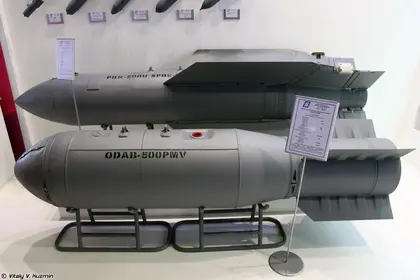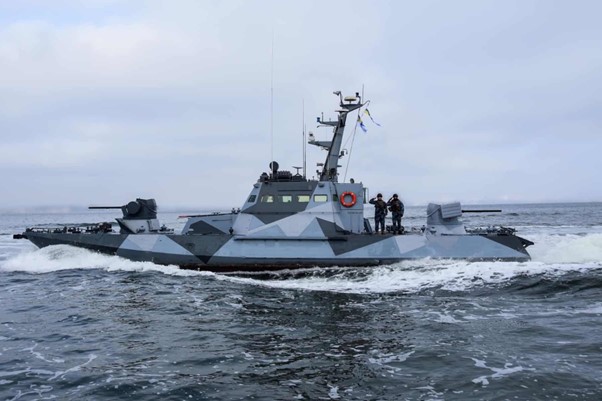Principle of action
Thermobaric weapons essentially differ from conventional weapons by the very principle of action: they explode like a small nuclear bomb – only without emitting radioactive particles.
JOIN US ON TELEGRAM
Follow our coverage of the war on the @Kyivpost_official.
A thermobaric munition consists of a container packed with fuel substance, the core of which has a small conventional-explosive “scatter charge container” with flammable substance and explosive. It does not explode instantly. When it reaches the target, the flammable substance disperses in the air, mixing with oxygen which catalyzes the explosion. A cloud of the explosive mix is formed within milliseconds, after which it is ignited by the detonator. Thermobaric weapons can act inside trenches, buildings and even bomb shelters, which is why they are very effective in urban conditions.
Why the US began to use thermobaric weapons
The United States took on thermobaric weapons during the Vietnam War, when it turned out to be very difficult to deliver munitions and other essential supplies to the US troops in the jungle with almost no patches of open ground for transport helicopters to land. The engineers were able to prepare a helipad in 24 hours at best, but the troops could not wait so long. That is why the command ordered the use thermobaric weapons for clearing the ground. Dropped from helicopters, thermobaric bombs burned away all vegetation in the designated spots. One such bomb was enough to make an improvised helipad.

UK Contracts Arms Makers to Make Artillery Barrels for Ukraine
Soon afterwards, the Americans began to use thermobaric weapons for clearing the jungle around their command posts and other important sites. Such weapons also proved very effective against the Vietcong troops who could not hide from the fire in any trenches, shelters or even underground labyrinths.
There are several types of thermobaric weapons in the Russian army’s arsenal and the invading forces make full use of the entire range – from handheld grenade launchers and flamethrowers with thermobaric munitions to heavy bombs. Recently, they used a 1,500 kg volumetric detonating anaerobic bomb, ODAB-1500 (the letters stand for the abbreviated type of munition and the number for the weight in kilograms). Previously, they had used ODAB-250 and ODAB-500 bombs weighing 250 kg and 500 kg respectively.
ODAB-1500
The explosion of this powerful bomb covers a very large area, causing a fireball as high as 60 meters. Hit by such a bomb, a multistory apartment building is simply razed to the ground.
The Russians drop these bombs from their Su-34 and Su-35 jets (some of which have been actively and successfully targeted by the Ukrainian forces of late).
Dropped from the carrier aircraft, the ODAB-1500 falls or glides until a parachute opens at the altitude of 50 meters to stabilize and slow the bomb down. Then, at 15 to 7 meters, the inbuilt altimeter activates the detonator and the bomb explodes. The midair explosion is more destructive and the blast wave expands further.
According to Ukraine’s military intelligence chief, Kyrylo Budanov, Russia dropped an ODAB-1500 on the village of Velyka Pysarivka, in the Sumy region. The fireball was seen from neighboring villages and towns as it rose up to one kilometer.
The Russians modify their standard free-fall thermobaric bombs by adding stabilizing wings and navigation aids. The range of such standoff bombs is longer, which means the bombers can drop them while remaining outside the range of Ukrainian air defenses.
Some experts warn that the Russians might soon begin to use ODAB-3000, i.e., 3-ton thermobaric bombs.
Russian heavy flamethrower systems
Back in the Soviet era, in order to compensate for the limited use of tactical aviation in all frontline sections, the TOS-1 Buratino heavy multiple launch flamethrower was developed for the Soviet Army. It was designed to fire incendiary or thermobaric 220mm rockets. Its range was 3,500 meters.
After the collapse of the USSR, the Russians deeply modernized the Buratino that had revealed a number of drawbacks. In 2001, the Russian army received the modernized version, TOS-1 Solntsepyok, and in 2020 the TOS-2 Tosochka. Solntsepyok’s volley capacity was increased to 30 thermobaric projectiles from Buratino’s 24 and its range to 6 km. Buratino and Solntsepyok were mounted on the tracked chassis of the T-72 tank and the Tosochka on the wheeled chassis of the Ural heavy truck.
The latter has both advantages and disadvantages: the wheelbase provides for higher mobility but makes the 18-round launcher mounted on an unarmored truck much more vulnerable.
Soviet designers also developed thermobaric munitions for other multiple launch systems, such as the 9M55S 300mm rocket for the Smerch MLRS. Similar rockets were also made for the Uragan MLRS.
Thermobaric weapons can be used even by rank-and-file Russian servicemen
There are also thermobaric munitions that do not necessarily have to be fired from special launchers or aircraft. The Russian military fire them from RPG-7 and RPG-32 grenade launchers as well as RShG-1 and RShG-2 single-use grenade launchers which are in service with ordinary infantry units. Some flamethrower units of the Russian army’s Chemical Force are also armed with Shmel single-use flamethrowers.
Does Ukraine have such weapons?
Ukraine inherited a certain quantity of thermobaric munitions for grenade launchers, flamethrowers and even some multiple launch rocket systems from the USSR, but that is far below comparison with the quantity of such weapons in the Russian army’s arsenal.
One of the instances of the Ukrainian military reportedly using a thermobaric weapon was for the assassination in February 2017 of Mikhail Tolstykh (callsign Givi), the ethnic-Russian-Georgian and Ukrainian-born commander of the so-called Donetsk People’s Republic’s Somalia battalion, which perpetrated war crimes against Ukrainian POWs. A thermobaric munition fired remotely from a Shmel flamethrower exploded right in his office in Donetsk.
In 2019, the Armed Forces of Ukraine began to use the newly developed RGT-27S and RGT-27S2 thermobaric hand grenades. They have proven very effective in clearing trenches and buildings as well as in destroying enemy vehicles. Dropped from an ordinary drone, this highly explosive munition completely destroys a tank or other armored vehicle, even if it does not fall into the open turret hatch, because the dispersed explosive mix penetrates inside anyway.
Over time, Russia’s all-out war has compelled Ukraine to develop new types of thermobaric weapons, destroying targets by means of a flammable mix that explodes inside buildings and vehicles, creating a lethal blast wave from the excessive pressure.
You can also highlight the text and press Ctrl + Enter










